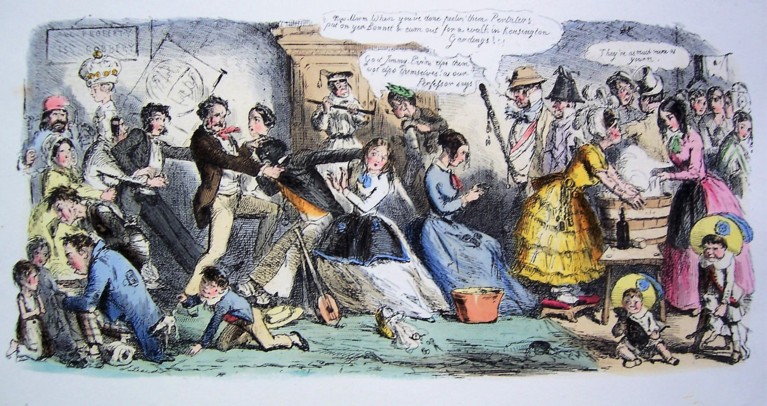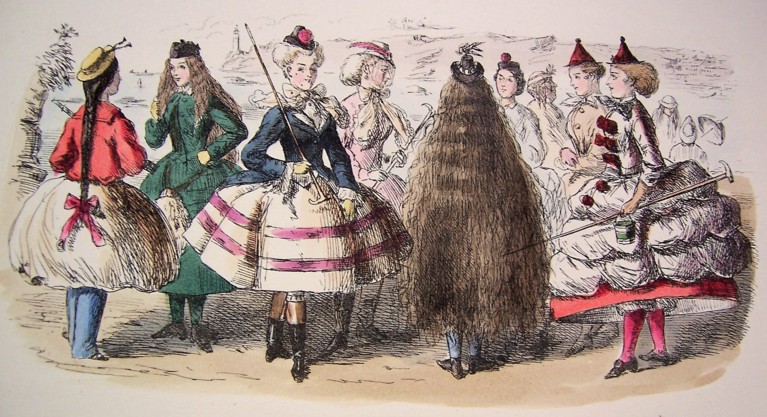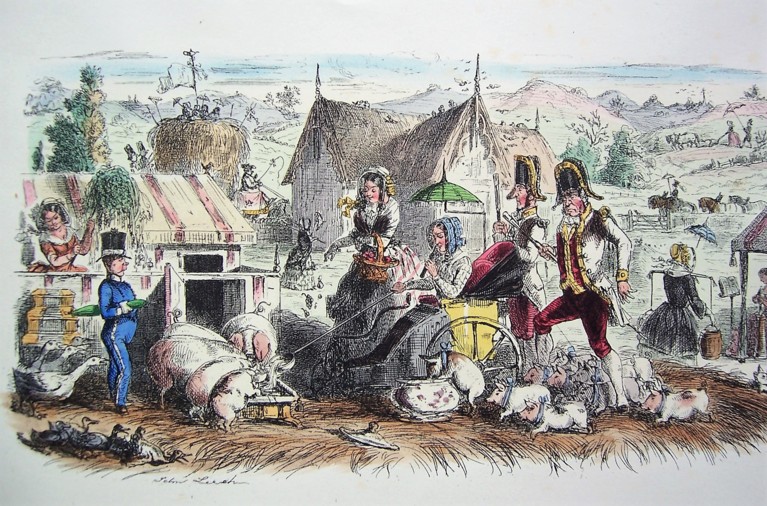Blog
20 April 2023

Locomotives belch black smoke into the air of Hyde Park, because everyone is riding an individual locomotive, sitting astride it like a horse. Centre-stage, Queen Victoria is seen riding in the Park in her carriage – except that it is being drawn by a smoky locomotive. Prince Albert doffs his top hat, acknowledging the crowds. Members of the Household Calvary escort the Queen, sitting astride locomotives. In the distance the chimney of some dark satanic mill is smoking …
‘Hyde Park as It Will Be’ is the plate for 1848 in John Leech’s Follies of the Year, a series of coloured etchings from Punch’s Pocket Books for 1844-1864, in Emmanuel’s Graham Watson Collection. Plates for each year present some wry view of contemporary trends and follies and where they might be leading, as in this not very optimistic perspective on the likely impact of the steam engine.
Some plates peer into a perhaps near future where customary order is disrupted.
In ‘A Social Sketch’ (for 1850) is ‘the communistic idea’. Far right, one says to another: ‘They’re as much mine as yours’. A ruffian wielding a stick looms over a lady and says: ‘Now, Ma’am, when you’ve done peelin’ them Pertaters, put on your bonnet and cum out for a walk in Kensington Gardyngs’. Behind, another says: ‘Evin ’elps them wot ’elps themselves, as our Perfessor says’. To the left, a white man and a man of colour appear to be fighting over a lady.

Pl 2. ‘A Social Sketch, or Everything in Common’ (1850)

Pl 3. ‘Higgledy-Piggledy, or a Domestic Republic’ (1849)
‘Higgledy-Piggledy’ (1849) shows ‘the idea of general insurrection and socialism’ in the domestic household. The master of the house (as he perhaps fancies himself) finds his household of women and childen in rebellious uproar, waving placards demanding more new dresses, more housekeeping money, a box at the opera, holidays every day, and (in an echo of the French Revolution) ‘Liberty, Equality, Fraternity – and Master to do the work!’
Running through the series of plates is a curiosity about the possible autonomy and independence of women. On the one hand, plates include some of the absurdities of fashion by which women are oppressed, such as the unlikely ‘Sea-Side Fashions’ for 1863 (including one very bad hair day), or a contraption to be worn underneath to support a crinoline, shown here being inflated by bellows.

Pl 4. ‘Some Sea-Side Fashions for 1863’

Pl 5. ‘Dressing for the Ball’ (1857)
But fanciful plates imagine a world where women engage hands-on in (as it seemed) unlikely occupations – such as pig farming. In ‘Farming for Ladies’ (1845) several well-dressed ladies attend to their pigs. Liveried footmen pushing one lady in a bath chair look glum as they tread on piglets. Up on a hillside behind a lady is ploughing while a man holds a parasol over her. Some ladies appear to be having tea atop a haystack, which sports a flagpole surmounted by a teapot.

Pl 6. ‘Farming for Ladies’ (1845)

Pl 7. ‘A Rather Fast Steeple Chase’ (1864)
Meanwhile, ‘A Rather Fast Steeple Chase’ (1864) shows an all-women’s horse race, with ladies flying over the obstacles with panache.
Another plate of women-only activity shows ‘Swimming for Ladies’ (1860), where women enjoy the water, albeit fully attired in cumbrous clothing.

Pl 8. ‘Swimming for Ladies’ (1860)

Pl 9. ‘A Substitute for the Sea-Side, or the Serpentine as it might be’ (1858)
Some women are also shown swimming fully clothed in ‘A Substitute for the Sea-Side’ (1858). Here, the Serpentine has become as promiscuously mixed and crowded as a seaside resort. The notices reflect concerns that are still with us: ‘As the Water is now perfectly pure and wholesome, The Public may bathe at All Times’, and ‘The Public are requested to protect the valuable collection of Water Fowl’ (although the burly swans seem to be managing just fine). Three young women are discussing: ‘Shall we row, dear, or shall Charles scull us about?’ (Charles in his boater awaits their decision, sheepishly).
The background to one wry plate almost entirely filled with women is a gold rush in Australia

Pl 10. ‘Alarming Prospect: The Single Ladies off to the Diggings’
A quayside is crowded with women who are setting sail from Britain to find themselves wealthy lovers in the gold fields: as the text says, ‘away go all the ladies to the diggings, despising the humble fortunes’ of their homegrown admirers. One lady snaps dismissively to a man: ‘A Cottage! Fiddle-de-dee, Sir!’ Another man kneels as a lady, nose in the air and wielding an enormous hat box, turns her back on him with ‘Bother yer Hunderd Pounds … A likely start indeed!’ A few crestfallen men perch in the middle of the quay, surveying the mass exodus of venturesome women.
Barry Windeatt (Keeper of Rare Books)
Images by Helen Carron (College Librarian)
